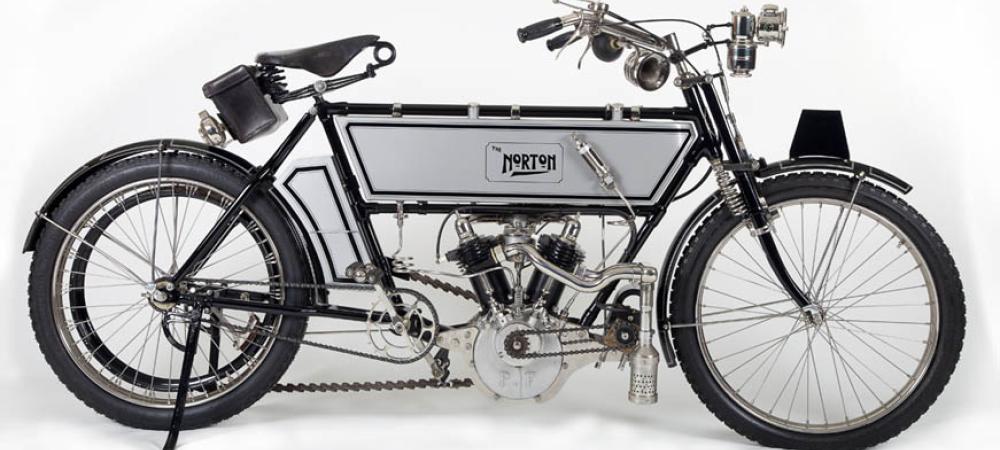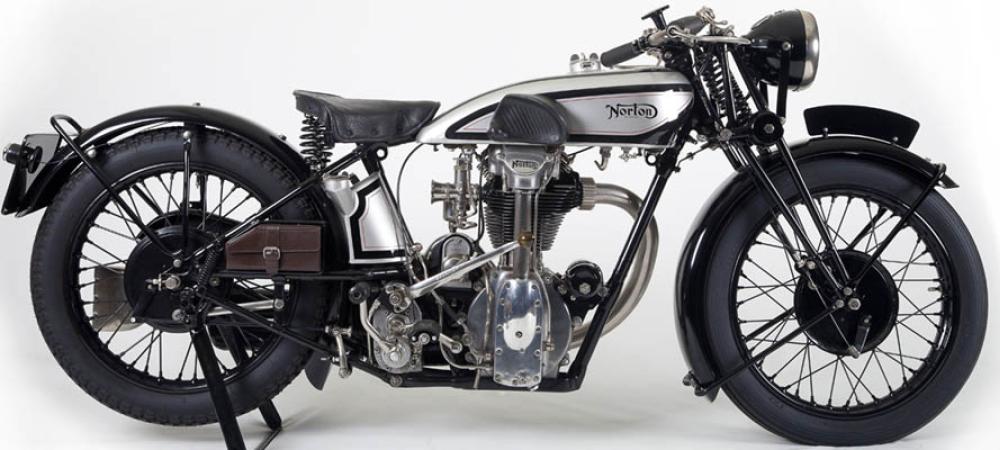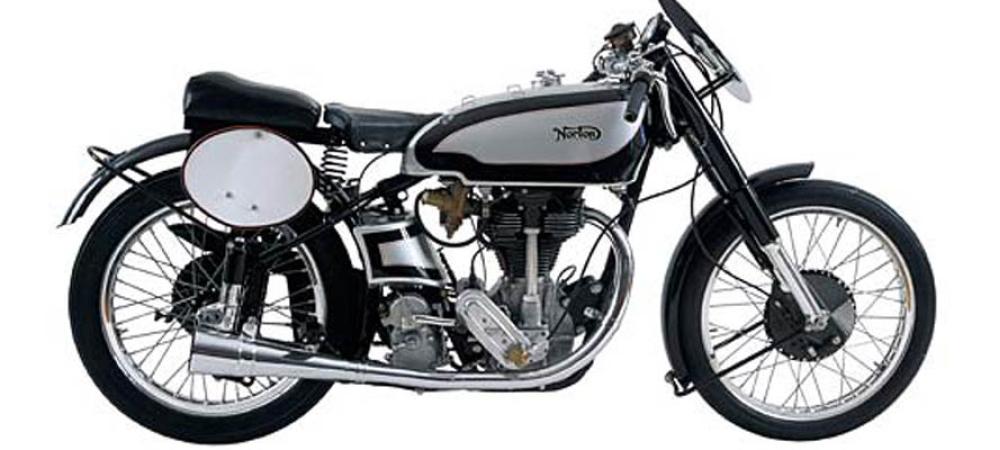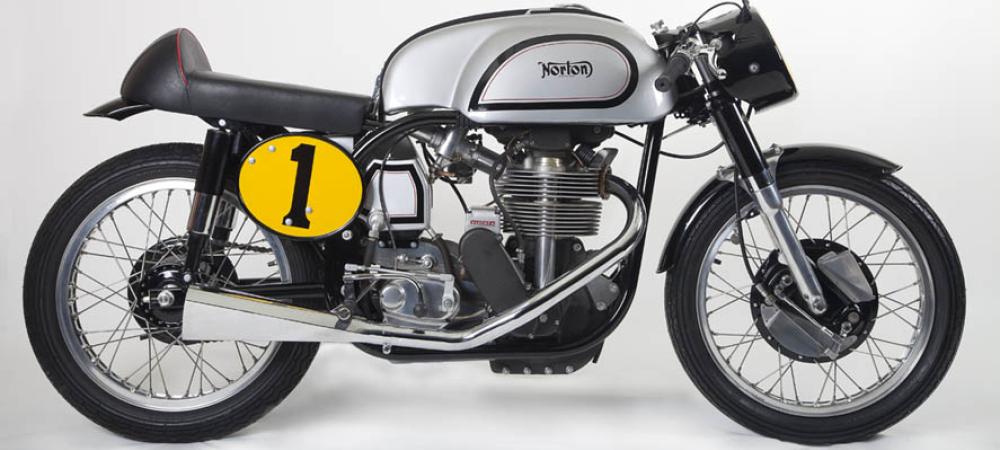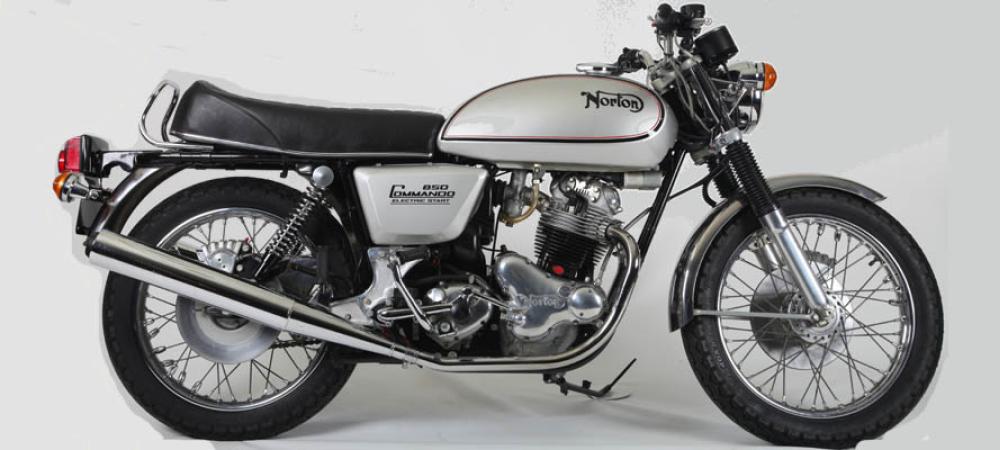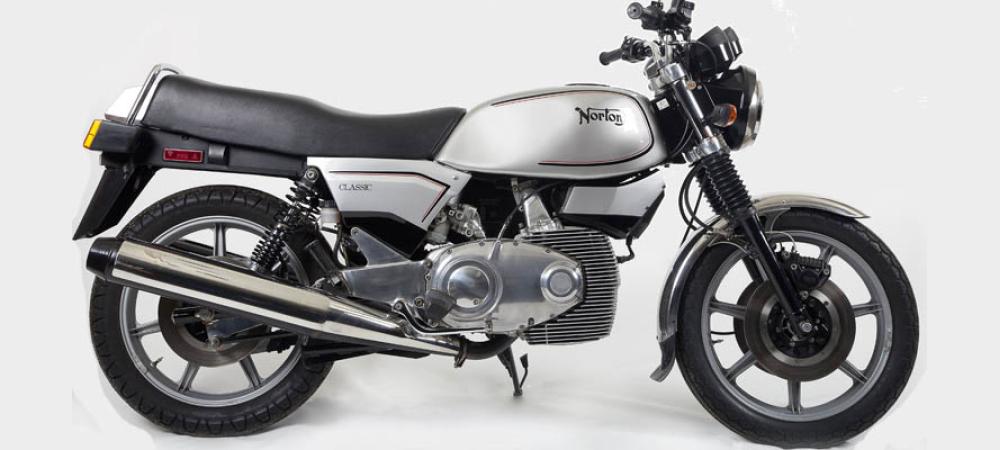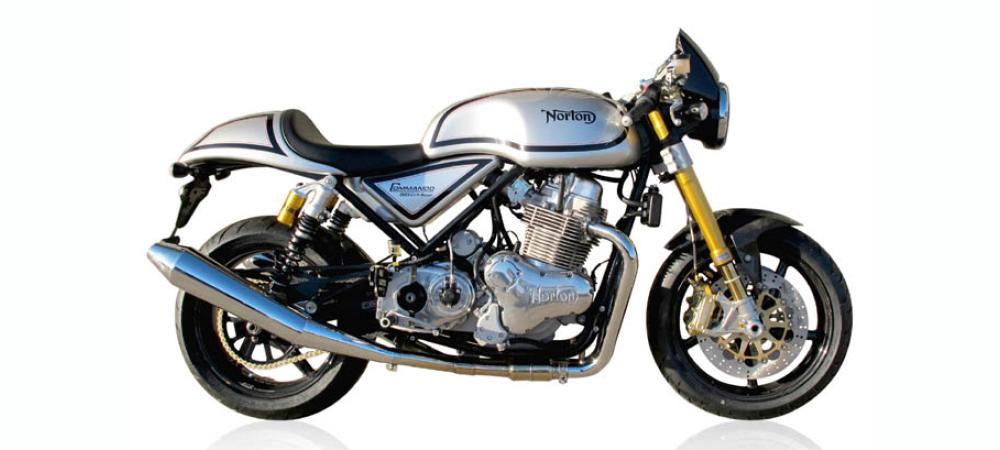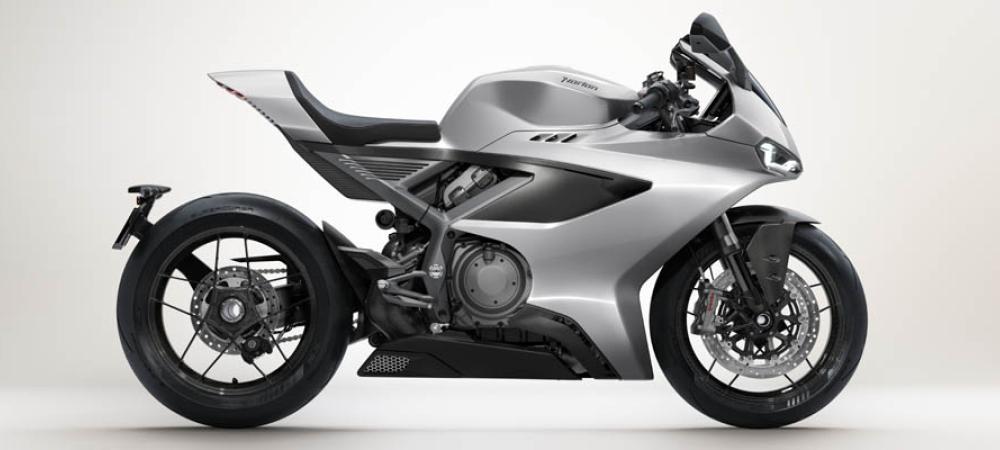1978 to Present
Rotary
The Wankel rotary engine dates back to before WW2 in its conception, the German firm, NSU held the patent rights for use in motorcycle applications and coming to suitable arrangements with them was a drawn out affair. The engine virtually has only two moving parts, an eccentric shaft upon which is mounted the triangular rotor, or rotors as in the Norton motorcycle engine. The sealing of the rotor tips was a big problem for many years but modern technology overcame this as well as the other bugbear of inordinately high fuel consumption. The Interpol 2 frame was of sheet steel welded into a box section and providing a high degree of rigidity. The drive went via a duplex primary chain to an all metal diaphragm clutch, thence through a five speed gearbox to the totally enclosed rear drive chain. Twin 11" disc brakes at the front and single disc at the rear took care of stopping the machine. The Norton engine was the equivalent of 588cc, though some used a different method of measurement and claimed 1200cc. Either way, the power output was 82 BHP and weight 570lbs. complete with fairing and police equipment. Up to 1987 some 330 of these machines (P41) had been sold to the police, armed forces, and the RAC for use by their patrolmen. In the meantime a liquid cooled version was being developed, though it was kept well away from the curious eyes of visitors to the Shenstone factory hoping to catch a glimpse.
Norton Villiers Triumph Group (NVTG)
A civilian version of the air cooled Rotary was promised and then postponed many times during the mid-80s. All this altered suddenly early in 1987 when Norton changed hands, the major shareholder being Philippe Le Roux who became the new Managing Director of Norton Villiers Triumph Group plc (NVTG). The selling of the Rotary to the public and the continuation of the Commando spares business were early stated aims, and the former was at long last realised in October 1987 when a 100 off batch was made available at a price of £6,000 each, This machine was called the Classic (P43) and it seemed likely that no further air cooled machines would be sold as the future undoubtedly lay with the water cooled engine. In 1988, Norton Motors Deutschland GmbH was set up by the company as a joint venture with Joachim Seifert; this was to have significance later in the Norton story.
Police (P52) and civilian (P53) versions of the water cooled Commander were both launched in mid-1988. Although the forks, brakes and wheels on the Classic were of Italian origin, Yamaha now took over the supply of these. A later version of the civilian Commander featured integral panniers and was known as the 'Krauser'.
In 1990, Norton released the Spondon framed F1, a beautifully styled machine in black with the engine reversed, a fully enclosed fairing and Mikuni carburettors. The design owed something to the RCW588 racer on which the late Steve Hislop won the 1992 Isle of Man Senior race in an epic tussle with Carl Fogarty on a Yamaha. The F1 could be prone to overheating and in 1991, the F1 Sport appeared, with SU carburettors and a more openly structured fairing producing a bike which looked very similar indeed to the race machines. The Rotary line came to an end in 1992 with the last of the Commanders.
Norton Goes Abroad
Over the following years, the ownership of the company changed several times and the rights to the use of the Norton name and associated trademarks were frequently in dispute. In 1991, Norton ran into further financial problems and the spares stock was sold back to Andover Norton. In 1994, the Regal Group purchased Andover Norton and the spares operation moved to Southampton. David MacDonald replaced Le Roux at Shenstone, then the part of the company making rotary engines for military and other uses was sold off. Canadian entrepreneur Nelson Skalbania, known more for his investments in real estate and sporting ventures became the owner of the remaining business. Meanwhile in 1996, Joe Seifert and Richard Negus started Norton Motors Ltd. in England, concentrating on spares and service for the Rotaries.
In April 1998 the formation was announced of Norton Motors International Inc. (NMI), a combination of Norton Motorcycles Ltd. of Shenstone and March Motors International Inc. of Minneapolis, USA. The board of directors included Luigi Aquilini who like Nelson Skalbania before him also came from Canada, and English engine designer Al Melling. The new company claimed trademark rights to the use of the Norton name in the USA, UK and parts of Europe. Plans were announced for an ambitious range of machines to be on sale later that year following a refurbishment of the now very tired looking Shenstone facility. Top of the range was going to be the ill fated 'Nemesis' which had it ever reached production would have been the fastest Norton ever, perhaps the fastest motorcycle in the world. Using a 1500cc 4-valve per cylinder fuel-injected V8 engine having no less than three spark plugs per cylinder, designed by Al Melling, the machine was intended to produce up to 280HP. It was also to have active suspension, push button gear changing and with a magnesium alloy frame weighing just over 200kg should have achieved a top speed of over 220mph and 0-60 in under 2.5 seconds. The project foundered, as did Norton once again and there followed shortly afterwards yet another change of ownership.
Meanwhile, Joe Seifert who had retained the rights to the use of the Norton name not assigned to NMI, started manufacture of his own Norton range. The first (and only) machine was the 1999 C652SM (Supermono) International with a Tigcraft frame and 652cc Rotax engine. Just a very few of these were manufactured.
Kenny Dreer, a Norton enthusiast based in Oregon had for some time been operating his own company, Vintage Rebuilds. He had started by taking donor Commandos and turning them into very stylish custom machines typically featuring plenty of chrome plating and striking paint schemes together with upgraded mechanical components. This series of machines was the VR880. In 2003, in partnership with a previous customer Oliver Curme who now became the financial backer, the two of them became as Norton Motorsports Inc., the new owners of the Norton name. At the same time, they consolidated into the company the rights previously owned by Joe Seifert.
The company had been working on development of a 'new' Commando and about this time the prototype 952 was first seen. Further development work over three years and around $10 million later, Dreer had produced the 961 Commando prototype but the finances to make the move to volume production were not forthcoming and the project had to come to a halt in April 2006.
In 2007, Norton Motors Ltd., purchased Andover Norton from Regal and moved it to Hungerford.
Norton Comes Home
For a while the Norton name once more lay dormant with no machines being produced nor any purchasers for the company. Back in England, Stuart Garner, the owner of several businesses and a motorcycling enthusiast for a number of years was already a partner in Spondon the frame manufacturers. Via this route he met Brian Crighton who was at that time building up the National Motorcycle Museum sponsored Rotary and his interest grew. In October 2008, a deal was done, the Norton name returned to its country of origin under Garner's ownership and a new team was set up in a factory at Donington Park. Norton Racing, the competition arm of the company, developed a 2009 version of the NRV588 Rotary which made its Isle of Man TT debut in mid-June 2009. Future plans included a road going version of the Rotary racer.
In 2010, Norton Motorcycles (UK) Ltd. launched the Commando 961SE, which was followed later in the year by production runs of two other 961 variants, the Café Racer and Sport. A dual seat option was then offered. The range subsequently passed the required standards for the machines to be sold into Europe and in 2012 also completed the durability and emission testing enabling Norton to supply bikes to the North American and Canadian markets.
Initially the company was based at a small industrial unit in the East Midlands but this quickly proved to be too small. Therefore, in 2014 Norton Motorcycles moved to a new facility in the grounds of Donington Hall, Castle Donington. Simultaneously, the Commando 961 model range was updated with a number of improvements which included redesigning the oil pump, a cast clutch-basket, Nikasil-lined cylinders and upgrading of some of the parts in the cassette-gearbox. The Mk.II 961 was unveiled at the motorcycle show in autumn 2015 and available to order for the 2016 model year. There was a much wider range of colours and some inspiration was drawn from the US-specification Commando models of the 1970s, with bright, metal-flake colours and wider and taller handlebars.
During this period Norton made an unexpected return to racing at the Isle of Man TT. The TT machine used an Aprilla V4 engine housed in a Norton frame. Some top riders were engaged to ride the bikes and although they did not win any races, they did set some respectable lap times and generated a lot of interest. In 2016 Norton were ready to announce their own V4 engine superbike. There were two versions of the 1200cc machine; the SS retailing at £44.000 and the RR priced at £29.000. Sadly, however, in January 2020 Norton Motorcycles (UK) Limited went into administration.
Norton Motorcycles taken over by TVS
In April 2020 it was announced that Norton Motorcycles had been purchased by the TVS Motor Company of Chennia. Although not widely known in the UK, TVS are the third largest motorcycle manufacturer in India. Founded in 1911 by T. V. Sundram Iyengar, TVS has steadily expanded and since the year 2000 has worked in partnership with Suzuki, built BMW motorcycles under licence and even entered a team in the Dakar Rally.
After taking over Norton Motorcycles TVS have made a large investment in the company. The most obvious evidence of this has been the move from Donington Hall to a large modern facility at Solar Park in Solihull, Birmingham. Early efforts were directed towards fulfilling orders for motorcycles paid for but not delivered under the previous owner.
Initial press releases suggested that the new owners would concentrate on developing a range of electric motorcycles. However, in October 2022 they announced that a new version of the Commando 961 would be available in early 2023. Although visually the same as the Donington era 961, Norton Motorcycles stated that they had made a number of design improvements in an effort to improve quality and reliability. Two models, the Sport (SP) and the Café Racer (CR), were introduced, both being available in black or silver. Also announced in 2022 was a re-engineered version of the V4 superbike. This would be called the V4SV and would be available in two options, Manx Platinum or Carbon Fibre.
In 2023 Norton Motorcycles announced the introduction of a new motorcycle. This would be a stripped back version of the V4 and would be called the V4CR (Café Racer) and again the bike would be available in Manx Platinum or Carbon Fibre. In late 2023 Norton also unveiled a new range of Special Editions models to celebrate the 125th anniversary of Norton. These SE machines would be styling variants of the Commando 961 and the V4 based on themes from Norton’s most iconic models. Each production run was to be limited to 125 machines.
Since the restart of motorcycle production Norton Motorcycles have been active in creating a UK Dealer network to sell and support their products. The company also markets their bikes via their website and through their attendance at major motorcycle shows.
What is now most eagerly awaited by all Norton enthusiasts are some new models, which we hope cannot be too far away!
So, over a century on, the Norton name is back where it belongs and new motorcycles with Norton on the tank are being seen on both the road and race track. James Lansdowne would be very pleased indeed.
© Norton Owners Club 2010

